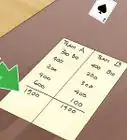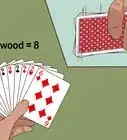wikiHow is a “wiki,” similar to Wikipedia, which means that many of our articles are co-written by multiple authors. To create this article, 10 people, some anonymous, worked to edit and improve it over time.
This article has been viewed 96,302 times.
Learn more...
Karuta is a common card in Japan. This game has traditionally been played for hundreds of years in Japan, dating back to some of the most famous Japanese dynasties. It's a good game for children who are too young to understand more complicated gaming rules, as well as adults looking to have fun and improve their foreign language skills. With a few simple purchases, and a little bit of practice, you will be on your way to learning the fun card game known as karuta!
Steps
Preparing to Play Karuta
-
1Buy the cards you want to use. Traditional karuta cards come in two forms: yomifuda and torifuda. Yomifuda, or "reading cards," are cards with information (clues) written on them in Japanese. Torifuda, or "grabbing cards," are cards with written Japanese information on them pertaining to the clue cards. Both yomifuda and torifuda cards come in decks of 100 cards. In order to play, you will need one deck of yomifuda cards, and one deck of torifuda cards.[1]
- These can be bought off of popular sites such as Amazon and/or Ebay, as well as traditional Japanese specialty shops.
- Karuta is a great time to improve your Japanese reading and speaking skills. However, if you do not know Japanese, and have no interest in learning it, you can find versions with the language you speak.
- If you so choose you can also avoid karuta cards all together and replace them with traditional playing card decks. Because the sets come in decks of 52, you will need one playing card deck to replace the "reading cards" and one deck to replace the "grabbing cards."
-
2Select your tatami mat. A tatami mat is a traditional small rug which is often used for ceremonies. During the game of karuta, each player positions his or her body on the mat. Japanese style tatami mats can be found at online retailers, or Japanese specialty shops. However, you can also replace the rug with something more widely available, such as a small rug, or yoga mat.[2] [3] [4]
- Note that rugs are not necessary to play the game. It is traditionally thought that the originators of the game played on tatami mats. The use of the mats in today's game is mostly for aesthetic purposes, to feel as if you are playing a truly ancient game.
- If you buy, or cut, your own rug, make sure it is large enough to cover your knees, lower legs, and feet, as you will be bent down on them as you play. If you are going to buy a precut mat, measure the distance from your knees to your feet before you make any purchases.
Advertisement -
3Clear out a space to play. You will need at least a 4X6 foot space to lay out the cards, and position both of the player's bodies. A normal kitchen table will work just fine if you are sitting in chairs, rather than the floor. If you do use the floor, as is traditionally done, make sure that the space is cleared so you have plenty of room.[5] [6]
- Whether you use the floor or the table, they both need to be cleaned beforehand. This means vacuuming the carpet, and wiping off the kitchen table. You do not want your bodies, or the cards to get dirty.
- Remember that you will also need a spot for the reader to sit as well. Note that the reader must be equidistant from both players, so a cleared spot favoring one player will not do.
-
4Find and choose a reader. While you may have someone else to play with, you need a third person. This person will read the "reading" cards and speak what they say. This person could be a friend, or a relative. They should have a clear speaking voice, and have no rooting interest. One of the players cannot be the reader as that would give him or herself a distinct advantage over the other player.[7] [8]
- Inform the potential reader that a traditional match only lasts 5-10 minutes. If the players only want to play once, the reader will not have to take much time out of his or her day.
Setting Up the Game
-
1Shuffle and deal the "grabbing" cards. For more information on how to shuffle a deck of cards, please visit this link: How to Riffle and Bridge Shuffle. After you have shuffled the cards, give the deck to the reader. The reader will deal the cards, giving a card to each player, one at a time, until each player has 25 cards. The other 50 cards in the deck of "grabbing" cards will not be used.[9] [10]
- Note: If you are using decks of regular playing cards, "grabbing" and "reading" cards are the same. Use a regular deck of playing cards, shuffle them, and give each player 26 cards.
-
2Shuffle the "reading" cards. To learn how to shuffle, please visit: How to Riffle and Bridge Shuffle. After the cards are shuffled, the reader will take the deck, and place it face down next to him or herself. All 100 reading cards are used in the game, so there is no reason to discard any.[11] [12]
- Note: If you are using decks of regular playing cards, "grabbing" and "reading cards" are the same. Shuffle one deck of playing cards (minus the jokers) and place them next to the reader as stated above.
-
3Flip the "grabbing" cards over. Each player will flip over their 25 "grabbing" cards so that they are face up. Each player will then arrange the cards so that they are in three, roughly equal rows. Rows of 8, 8, and 9 are usually used. Each row should have a 1 cm gap in between them.[13]
- The cards should not go past the size of the tatami mat, or roughly 87 cm wide.
- Each opponent's territory should be no more than 3 cm away from one another's.
-
4Situate your body positions. Each player should either sit or crouch (both should be doing the same thing). They should position themselves no closer than 1 foot away from their territory. Each player's position should also be equidistant to the position of the reader.[14]
-
5Memorize the position of each of the "grabbing" cards. Each player has 15 minutes to memorize the position of the grabbing cards. Note: when playing the game, you will have to touch cards on your territory, as well as cards on your opponent's territory. Make sure to memorize your opponent's cards as well as your own.[15] [16]
Playing Karuta
-
1Say what the first reading card says. The reader picks up the top reading card of the reading card deck. The reader than says loudly, slowly, and clearly, what the card says. That card is then discarded. The reader then waits until the players have touched one of the grabbing cards to continue on with the game.[17]
- If you are using regular playing cards, read the type of card. For example, "Ace of spades."
-
2Touch one of the grabbing cards. Once the reader has stated what was on the reading card, it is then the players' turn. It is the players' job to find the grabbing card which corresponds with the clue given on the reading card. The correct grabbing card could either be on your side, or your opponent's side. The second you see the card, touch it before your opponent touches it.[18]
- If you are using regular playing cards, find the playing card which matches with the reading card. For example, if the reader calls "Ace of spades," find the ace of spades.
-
3Keep the card you touched first. The player who touches the correct card first gets the point. He or she places the card next to them, away from the playing field. You will form a pile of cards as the game goes along. Each of the cards is worth one point.[19]
-
4Penalize the players. If a player touches a card that is not the correct card, they forfeit their next turn. They must place their hands on their head as the next turn commences. You also forfeit your next turn if the reader catches you out of position. This might mean that you are leaning, while your opponent is seated properly.[20]
-
5Repeat the previous steps. The reader picks up a card and reads it out loud. The players choose the correct corresponding grabbing card. Whichever player touches the correct card first gets to keep the card, and therefore gets the point. After all of the grabbing cards have been recovered, the reader counts up all of the cards for each player. The person with the most cards at the end wins the game.[21]
Community Q&A
-
QuestionWhat if we touch the card at the same time?
 Community AnswerIf the card is on your side, you would get it. If the card is on your opponent's, he would get it.
Community AnswerIf the card is on your side, you would get it. If the card is on your opponent's, he would get it. -
QuestionHow do I know if I am correctly grabbing the card?
 Community AnswerYou can swipe at the card or just pick it up, there really is no correct way.
Community AnswerYou can swipe at the card or just pick it up, there really is no correct way. -
QuestionWhat happens when a player touches the card?
 Community AnswerThe player will get the card and then you carry on with the game, so try to touch the right card quickly.
Community AnswerThe player will get the card and then you carry on with the game, so try to touch the right card quickly.
Things You'll Need
- Karuta cards (both reading and grabbing decks) or two decks of playing cards.
- A space to lay the cards on.
- At least two players
- A reader
- Tatami mat (optional)
References
- ↑ http://www.tofugu.com/2014/07/18/gotta-catch-em-all-karuta/
- ↑ https://www.haikudesigns.com/tatami-mats.htm
- ↑ http://www.chopa.com/ShopSite/traditional_tatami_mats.html
- ↑ https://sfmurasamekaieng.wordpress.com/what-is-karuta/
- ↑ https://sfmurasamekaieng.wordpress.com/what-is-karuta/
- ↑ http://chihayafuru.wikia.com/wiki/Hyakunin_Isshu_Karuta
- ↑ https://sfmurasamekaieng.wordpress.com/what-is-karuta/
- ↑ http://chihayafuru.wikia.com/wiki/Hyakunin_Isshu_Karuta
- ↑ http://chihayafuru.wikia.com/wiki/Hyakunin_Isshu_Karuta
- ↑ http://www.tofugu.com/2014/07/18/gotta-catch-em-all-karuta/
- ↑ http://chihayafuru.wikia.com/wiki/Hyakunin_Isshu_Karuta
- ↑ http://www.tofugu.com/2014/07/18/gotta-catch-em-all-karuta/
- ↑ http://chihayafuru.wikia.com/wiki/Hyakunin_Isshu_Karuta
- ↑ http://chihayafuru.wikia.com/wiki/Hyakunin_Isshu_Karuta
- ↑ http://chihayafuru.wikia.com/wiki/Hyakunin_Isshu_Karuta
- ↑ http://www.tofugu.com/2014/07/18/gotta-catch-em-all-karuta/
- ↑ http://www.tofugu.com/2014/07/18/gotta-catch-em-all-karuta/
- ↑ http://www.tofugu.com/2014/07/18/gotta-catch-em-all-karuta/
- ↑ http://www.tofugu.com/2014/07/18/gotta-catch-em-all-karuta/
- ↑ http://www.tofugu.com/2014/07/18/gotta-catch-em-all-karuta/
- ↑ http://www.tofugu.com/2014/07/18/gotta-catch-em-all-karuta/
About This Article
To play karuta, the reader shuffles the grabbing cards and deals each player 25 cards. Next, the reader shuffles the reading cards and place the deck face down. Then, the players flip over all of their grabbing cards and spend 15 minutes memorizing the card positions. Finally, the reader picks up a reading card and reads it aloud. The players must find the grabbing card that corresponds to the reading card and touch it. To learn more about how the game proceeds, read on!


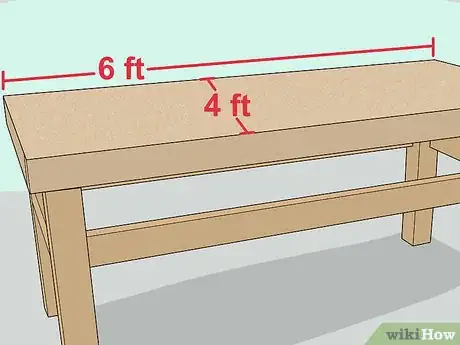
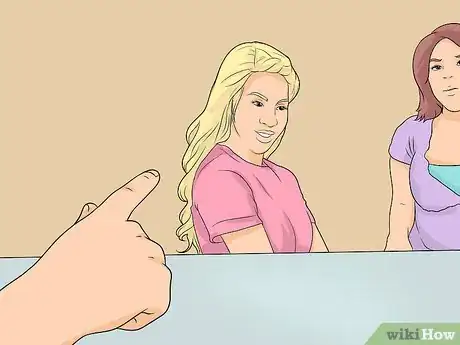

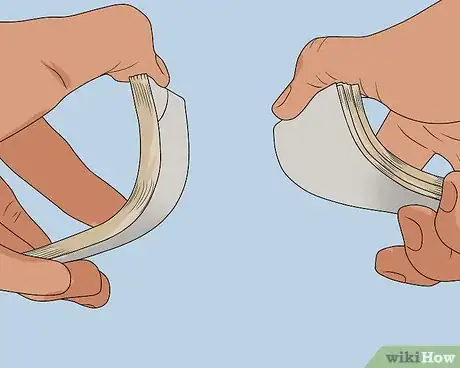
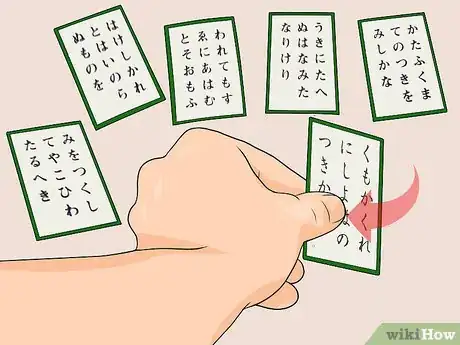


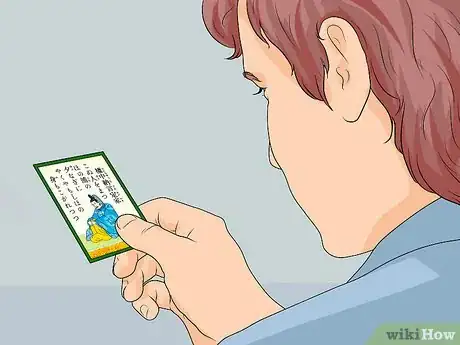


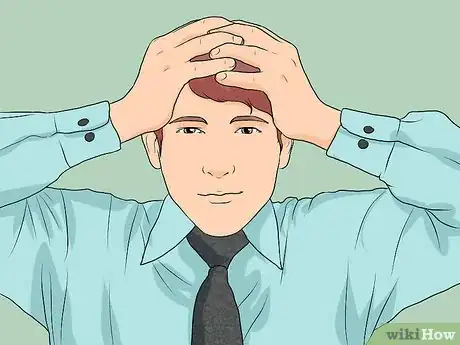
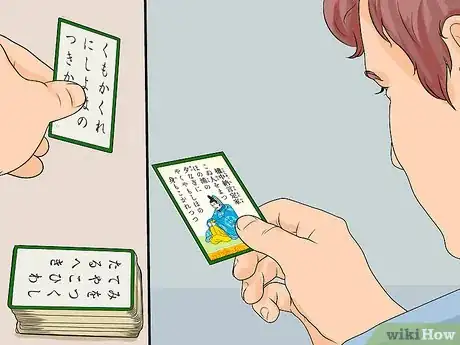
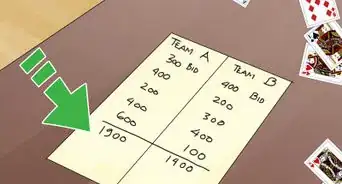
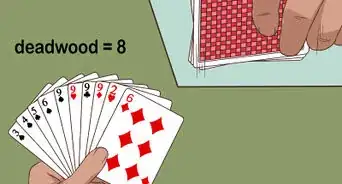

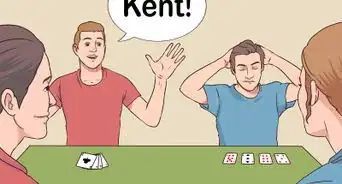
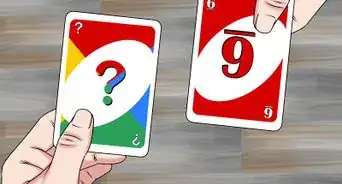


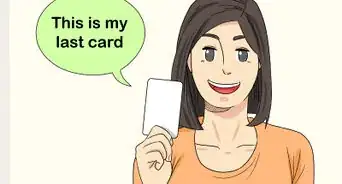
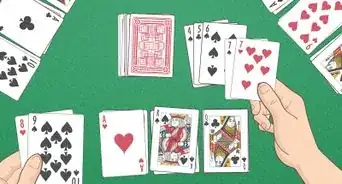
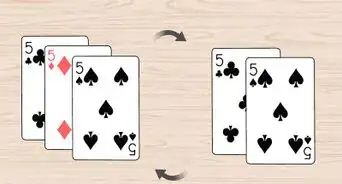
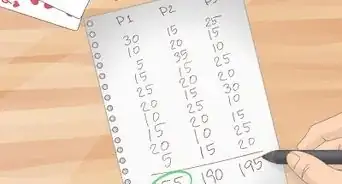


-Step-17.webp)








